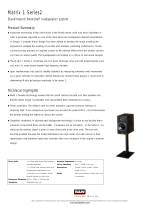
7
proceed to “Installing the LCR80 using
Rear Stabilizers”.
2. The LCR80 Loudspeaker is also supplied
with On Wall Mounting Brackets and
Hardware. If the LCR80 is to be mounted
on the wall at this time, proceed to “In-
stalling the LCR80 On the Wall” on
page 8.
To protect the fine finish of the LCR80 Loudspeaker
System during the installation process, it is advisable
to prepare a suitable area. A freshly vacuumed car-
peted area covered with a soft, clean fabric, such as a
large bed linen or blanket would be suitable.
It is recommended that the Professionals at your
McIntosh Dealer, who are skilled in all aspects of
installation and operation, install the LCR80 Loud-
speaker System and any associated audio equipment.
Note: Refer to illustration on page 15 for unpacking
the loudspeaker.
1. Orient the LCR80 shipping carton with the letter-
ing on the outside of the carton oriented upward.
2. Carefully cut open the shipping carton sealing
tape and open the carton flaps.
3. Remove the Loudspeaker System with end foam
pads by lifting up on the rear of the Loudspeaker
and place it along side the shipping carton on the
prepared flat surface.
4. Remove the accessory pack.
5. Release the Loudspeaker and the box containing
the Grille from the foam pads and set them aside.
6. Close the top flaps of the shipping carton and
place the top and bottom foam pads on top of the
carton. Refer to figure 1. A for the next several
steps.
7. Carefully remove the protective fiber cover from
the Loudspeaker System so as not to mar the fin-
ish. Then remove the protective plastic film wrap
from the Loudspeaker Cabinet.
8. Place the just removed protective fiber cover on
top of the shipping carton/foam end pads.
9. Place the Loudspeaker System, with the front fac-
ing down, on top of the protective fiber cover.
Notes: 1. When the LCR80 is to be used with the
supplied Rear Stabilizers and Hardware,
ment in the room. When the de-
sired angle is achieved, tighten the
screws. Refer to figures 3 and 4.
14. The LCR80 Loudspeaker Grille is
secured to the Loudspeaker Cabinet
with magnetic fasteners. Locate
the Loudspeaker Grille and align it
with the edges of the cabinet.
Note: Retain the shipping carton, foam packing ma-
terial and fiber cover for possible future use.
15. Optionally, attach the supplied McIntosh Logo to
the Front of the LCR80 Loudspeaker Grille in the
desired location, along either enge of the grille.
16. Proceed to “Room Acoustics and Loudspeaker
Placement” on page 10.
10. Attach the two rubber bumpers into bottom side
of the LCR80 and two onto the bottom side of the
Rear Stabilizers.
11. The LCR80 is shipped with the Rear Stabilizers
set for placing the Loudspeaker in a perpendicular
position. If this is the desired position proceed to
step 14.
12. To change the postion, loosen but do not remove
the two screws securing the position of the Rear
Stabilizers to the back of the LCR80. Refer to
figure 2.
13. Move the Rear Stabilizers up or down for the
desired angle (±11 Degrees from perpendicular).
This allows the sound to be directed upwards or
downwards to accommodate the seating arrange-
Unpacking the Loudspeaker
Rear Stabilizer Vertical Adjustment Positions
A
B
C
Figure 4
Installing the LCR80 using Rear Stabilizers
Rear Stabilizers
End foam pads
Figure 1
Figure 2
Rear Stabilizer Screws
Rear Stabilizers
Figure 3
Rear Stabilizer
Vertical
Adjustment
Positions
A
B
C
Unpacking the Loudspeaker

















